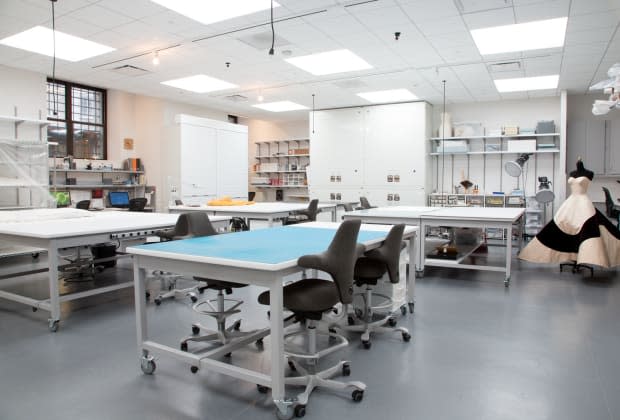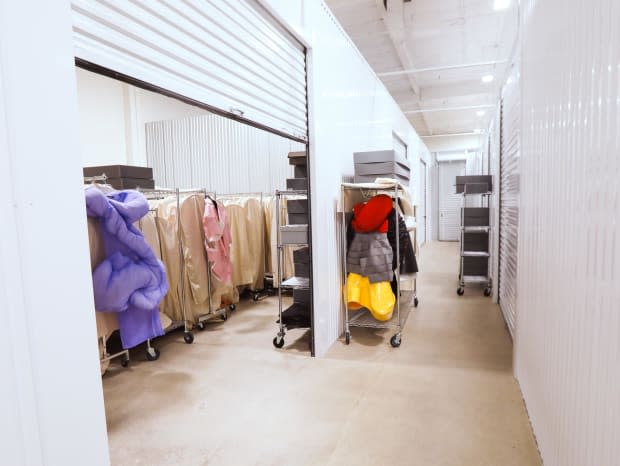Inside the World of Textile Conservation, Where Fashion and Science Meet
Conservators open up about their field — and how they got into it in the first place.
Clothing is a crucial part of our lives, and it's a portal to valuable information and clues about the lives of those who came before us. There's a lot of curiosity about what people wore when — just look at the crowds at the Met's Costume Institute exhibitions year after year. And it's thanks to the work of textile conservationists that we're able to learn more about the clothes of our forebears (and in Kim Kardashian's case, maybe even wear them).
Textile conservation is a unique field at the intersection of fashion, science, history and art. In addition to preserving the physical object, it's also about protecting the memory and social context that the object was worn or made within.
"We're only the temporary custodians of cultural heritage," says Sarah Scaturro, chief conservator at the Cleveland Museum of Art. "We aim to sustainably use our resources today so that future generations might have their chance at experiencing them."
Beyond extending an object's life expectancy for museum exhibitions, conservation is also important for the longevity of the fashion industry: Heritage houses might have a revolving door of designers at the helm, but each new creative director looks to the work of their predecessors to inform new collections.
"Getting to study the archives ensures that a new designer can carry forward the house's codes and DNA while synthesizing them with his or her own vision for the house," says Julie Ann Clauss, founder of The Wardrobe, a fashion archival service based in Los Angeles.
It's important to understand that, as a practice, conservation is intrinsically antithetical to the passage of time: Every work of art will eventually degrade — paint loses its pigments, celluloid in old photographs cracks, metal sculptures corrode, sunlight bleaches tapestries.
"We do have to accept this [reality]," Glenn Petersen, a conservator at the Met's Costume Institute, says. "However, our job is to slow down the deterioration process, for which there's often something that can be done. Even when an object seems like it might be a lost cause, knowledge and technology are always evolving, so there's the hope that objects we're not able to bring to a useable condition presently may be possible to treat in the future."

Photo: Courtesy of the MET
The Met's conservation lab, a state-of-the-art textile facility, is tucked below street level at the museum. There, Petersen and his team will use a variety of preservation techniques, such as stitching garments with a support fabric on the reverse or with a facing or overlay fabric. When it comes to materials like leather that can't easily be stitched, they may be treated with an adhesive. To clean pieces, conservators rely on a range of practices, from using a bulb blower, which uses air to gently remove debris, to full immersion wet cleaning, which is more intensive.
The Wardrobe — which preserves garments for designers, entertainers, costume designers and private collectors — follows a similar set of rigorous, scientific protocols. The entire facility is outfitted with full climate control to regulate temperature and humidity, plus hospital-grade air filtration. The team will also do regular cleaning and pest control.
View the original article to see embedded media.
Sometimes, conservators are not only working against time or the elements, but also against the objects themselves. Peterson explains that certain pieces are made from innovative materials that present challenges when it comes to conservation. Take, for instance, some of the Iris van Herpen gowns currently stored at the Met. One of these dresses is made from polyurethane, a "malignant" plastic that, Peterson says, can produce harmful degradation that can damage other materials in its vicinity. For this reason, the dress must be kept in a separate, oxygen-free storage room.
In addition to the materials and how an item's stored, conservators also think a lot about light. As The Museum at FIT's Ann Coppinger explains, "Light exposure is very damaging to an object. It can speed up degradation processes, fade dyes and dehydrate fibers, among other things."
However, light is necessary — not just to view the pieces you're working to preserve, but also to share them with the rest of the world. So, conservators will work hard to limit the exposure, as well as light level and type of light, to prolong the life of the object.
View the original article to see embedded media.
With all precious materials, there's a limit to what can be done, and there can come a point when conservators have to stop treating an object. Coppinger adheres to the conservator's code that "better is the enemy of good": Repairs are carefully delegated, but never be pushed too far. In fact, conservators have to provide research-backed rationale for each treatment.
"We're adding to the story of the object, but always with the wish to respect the original creator's intention," Coppinger says. "We strive to use methods and materials that are reversible."
Petersen echoes this sentiment: "We approach objects from a conservation standpoint (preserving what is there) rather than restoration (making it like new)."

Photo: Courtesy of The Wardrobe
When all the conditions are properly met, conservators will assess whether the garment is ready for display. "We like to limit exhibition times to three-to-six months," says Coppinger. They'll also think about how it's displayed — like ensuring that "the mannequin is the correct size and shape of the garment," so that it supports it without placing stress or strain on the fabric and so that it reflects an appropriate silhouette for the time period from which it was worn.
So, how does one even get into conservation? According to Petersen, a conservator at the Met's Costume Institute, textile conservation requires a breadth of skills, including the right academic degree, manual dexterity, cultural awareness and aesthetic sensitivity. Most institutions are looking for professionals who have completed a graduate degree in conservation, which already mandates certain prerequisites, like courses in studio and knowledge in some field of science.
One of the first hurdles, though, is knowing that the field exists at all: Many who have interests in museums, art, craft, history or science don't realize that textile conservation is a potential path for them.
After completing a conservation degree, many aspiring conservators go on to pursue fellowships before transitioning into full-time roles. That's what Scaturro did: A lifelong seamstress, she studied history and Italian — with some chemistry classes — in college, then found her way into conservation by taking continued-education courses in tailoring and pattern-making at the Fashion Institute of Technology and later enrolling full-time in its MA program in Textile Studies, with a focus in History, Theory and Museum Practice.
Because of the painstaking work of conservators, fashion lovers are able to appreciate the beauty of textiles, tapestries, carpets and embroideries for generations to come.
Never miss the latest fashion industry news. Sign up for the Fashionista daily newsletter.
